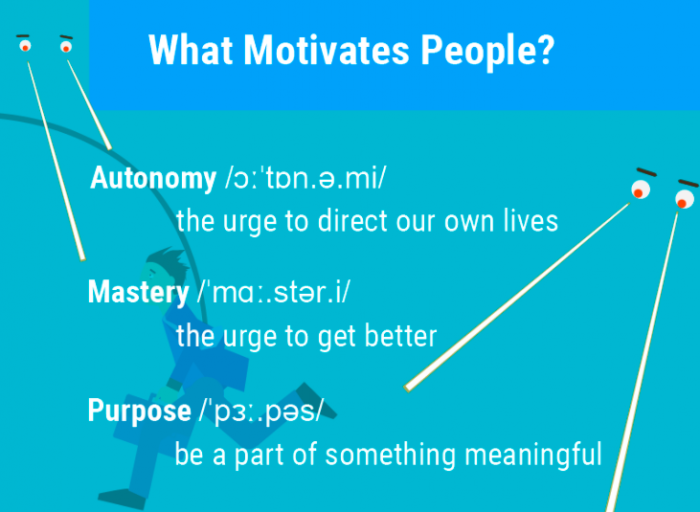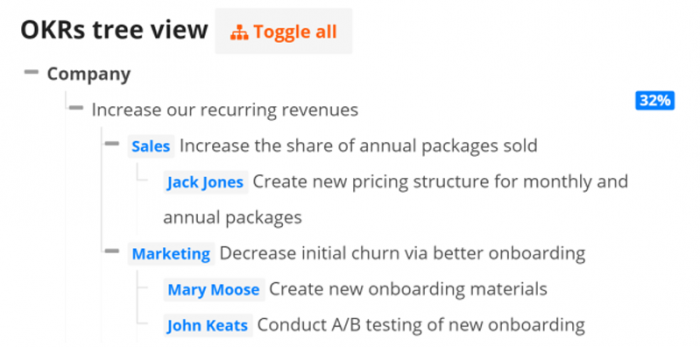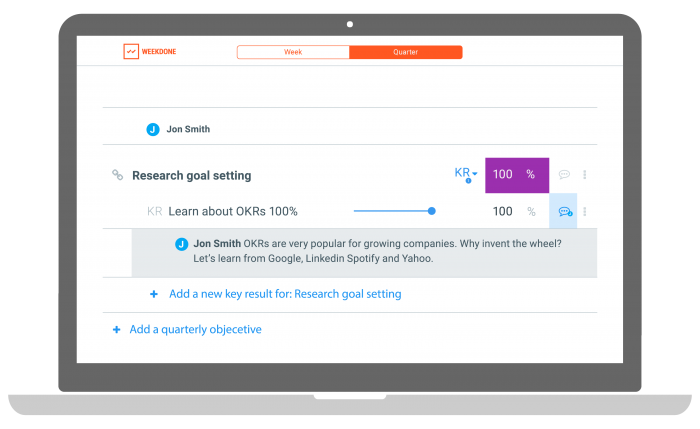Your team goals are vital to the success of your long-term projects. So keep reading if you want to make you next goal-setting process a success.
Imagine it’s the beginning of a new quarter. As you begin to pour your first coffee, your manager walks out of the monthly managers’ meeting smiling ear to ear. “Hey, do you have some time to discuss next quarter’s goals for the team?” And you agree, wondering what is about to come next.

You can tell his excitement as he pours on last quarter’s business results and shows some graphs he’s very proud about. He explains with enthusiasm how much growth the company will have, and then lists your goals which seem disconnected from all of his ideas. And then he already has your personal goals set for the next quarter bigger than the last. With a pat on your back, he gestures for you to leave with hardly any input from you.
I’m sure you would feel everything but motivated. You start to feel the pit in your stomach forming as you find yourself more disconnected from work than ever. And do you fully understand where that goal comes from, how you will achieve it, or why it was even chosen in the first place?
You realize in terror that you don’t understand any of your manager’s motivations. This is the experience so many employees feel. Of course, the story is dramatized and over the top, but it’s a lot closer to the truth than most of you might think.
What motivates people?
Before going into what you as a leader or a manager can do to get people engaged about their goals, let’s try to understand what motivates people in the first place.

Now, let’s analyze the whole scenario through these 3 motivational factors. Autonomy – a goal was given to a person without explaining how or why this goal is important. The person did not have a say in it. Maybe it was mentioned that the company needs to grow in revenue x amount of times, therefore you need to do x amount of more.
Using the words of a well-known author and motivational speaker Simon Sinek: “People don’t buy what you do; they buy why you do it”. In that case, an employee knows what he or she has to do, but doesn’t have a clue, why it is important. Most of all, the person was not involved in the process of coming up with a goal. In fact, employees who are involved in goal-setting are four times more likely to be engaged than other employees.
Mastery – giving a person an ambitious goal is a great start for a person to get better, but how? Some people are more independent and enjoy the task of figuring out how to achieve a given goal. This also goes nicely along with the Autonomy aspect.
Nevertheless, as a leader, it is your job to give some indication of how to achieve that ambitious goal. Some guidelines, a blueprint or even some tactical ideas. A sense, of what are the key performance indicators fulfilling that big ambitious goal.
Purpose – is intertwined with Autonomy. An employee wants to know why a particular goal is important. Especially, when more and more millennials are already making up most of the workforce. Millennials are not satisfied with a goal that is only meant to be done in order to get more growth.
They need a wider perspective.
People need to understand how their work impacts others and what is his or her role in achieving that overall arching goal. Even better, if you can explain how an individual goal actually impacts the person who is buying your service or product.
Motivating team goal-setting framework
Next step in getting people excited about their goals is picking the right goal-setting framework. Methodology, that takes into account the 3 motivational factors described above and offers more flexibility and transparency.

The best team goal-setting and tracking framework for companies and teams is the Objectives and Key Results methodology aka OKRs. The point of OKRs is to connect company, team and personal objectives in a hierarchical way to measurable results. That may not sound that exciting to an employee, but the impact of OKRs is making all employees work together in one unified direction.
It is no wonder why companies like Google, Facebook, LinkedIn are using them and tens of thousands of SME-s are following. OKRs allow each individual to see how their work impacts all the other teams and departments. Also, gives them a roadmap of what is needed to be done in order to achieve their objectives.
Keeping teams engaged with team goals
Consider also using individual employee goals. They increase job satisfaction and confidence amongst employees. Read more
A great goal-setting framework is a good start in making people motivated about their goals, but you as a manager, still have to help people understand why it is beneficial for employees to use a goal-setting format.
Here are the main reasons why OKRs are beneficial to a person. These are also the points you have to explain to your team in order to be aligned with 3 motivation factors and to get their buy-in.
- Clarity of what is expected from you and defined key results by which your success is measured.
- Transparency and alignment. You know how your goal is connected to the goals of your team, department and company. Giving you a sense of impact, connection and meaning. Instead of working in isolation and not knowing the impact of your work.
- Increase productivity by focusing on the right goals that are aligned with the overall business goals. Gives you that beacon to help you decide and prioritize what daily tasks are more important than others. Thus avoiding working hard on a project or presentation which might be discarded later on just because it wasn’t aligned to what management needed.
- Get praise and know what others are doing. By listing your quarterly or monthly goals and key results, everybody knows what you are focusing on and therefore don’t have to report as much. Also, it is easier to give feedback when everybody knows what you are up to.
- If done correctly, you as an individual would have a say in coming up with your goals and key success indicators. Therefore, have an impact on your goals right from the start, which should make you feel more engaged with your goals.

Setting goals with your team and creating a habit
Coming back to the beginning of the article, it is vital that you as a manager also involve your people in the goal-setting process. This way every person has a say in it and they are all invested in achieving their goals.
It is an amazing sight when everybody is working towards a common goal. You start to see the power of unity, making the work more efficient and less time consuming. In a way, this process consists both ways – top to bottom and vice versa. Here is my personal story and insights of how I set goals with my team.
As you probably know, only the act of setting goals and getting people motivated is not enough. You have to create a habit of setting and tracking your goals, so that it would have an impact on the actual outcome you as a leader are trying to achieve.
One part of creating a habit is you as a leader constantly asking people to review and update their progress. The second part is making the whole process of setting and tracking your goals as easy and comfortable as possible.

For that purpose I strongly advise you to use a tool or a software which supports the your goal-setting format and automates all the activities that you shouldn’t waste your time on. Lot of the people and companies are using spreadsheets to do their goal-setting, but about 75% of companies give them up, for the simple fact people not using them.
Therefore, if you are serious about getting people motivated and engaged about their goals, pick a tool that would make it as easy as possible. Then you will have a greater chance of creating a habit and people updating their goals on a regular basis. In case you want to implement Objectives and Key Results, I recommend Weekdone. Weekdone has a 2 week free trial and lets you use it for free with all features for up to 3 members.
More materials on goal-setting and OKRs: